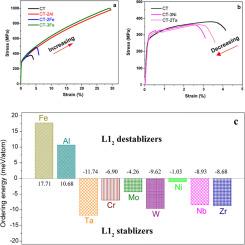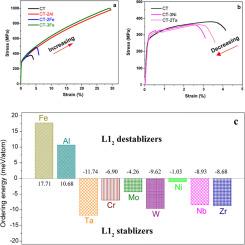Suppressing embrittlement and enhancing thermal resistance of bulk superlattice alloys by controllable grain-boundary segregation
IF 8.3
1区 材料科学
Q1 MATERIALS SCIENCE, MULTIDISCIPLINARY
引用次数: 0
Abstract
Severe grain-boundary embrittlement at ambient temperatures poses one of the most critical challenges for wide applications of superlattice alloys as high-performance structural materials. Indispensable active constituents like Al are recognized as the major cause of such embrittlement by releasing atomic hydrogen from moisture, which violently weakens grain boundaries (GBs) and promotes stress localization. Challenging conventional wisdom, here we surprisingly discover an anomalous ductilization effect in the L12-structured Co3Ti alloys, where Al alloying conversely suppresses the intergranular brittleness and meanwhile dramatically increases tensile ductility from ∼4.1 % to 30 %. Further experiments and calculations revealed that the grain-boundary brittleness in bulk L12 Co3Ti alloys is directly related to the preservation of L12 chemical order up to the boundary plane, which fortunately, can be destroyed by inducing Co-atom segregation through the alloying of a L12 destabilizer Al, as well as Fe. Such chemical-partitioning-induced disordered intergranular buffer significantly reduces the resistance to dislocation slip across GBs, which retards the development of slip-induced stress concentrations at GBs and hence reduces the likelihood of intergranular fracture. Moreover, the Co-atom segregation-induced grain-boundary phase together with the secondary L21 Co2AlTi phase in the Al-alloyed alloy significantly improves thermal resistance to grain coarsening. The kinetic exponent and apparent activation energy for grain boundary migration in unalloyed Co3Ti increases dramatically from 3.2 to 263.7 kJ/mol to 5.2 and 641.0 kJ/mol, which surpass documented values of Ni- and Co- based superalloys, suggesting their promising potential as heat-resistant materials. These findings pave a new way for developing high-performance, heat-resistant superlattice alloys.


通过可控晶界偏析抑制块状超晶格合金的脆化并提高其耐热性能
环境温度下严重的晶界脆化是超晶格合金作为高性能结构材料广泛应用所面临的最严峻挑战之一。铝等不可或缺的活性成分被认为是造成这种脆性的主要原因,因为它们会从水分中释放出原子氢,从而严重削弱晶界(GBs)并促进应力局部化。与传统观点不同的是,我们在 L12 结构的 Co3Ti 合金中意外地发现了一种异常的延展效应,即 Al 合金反过来抑制了晶间脆性,同时将拉伸延展性从 4.1% 大幅提高到 30%。进一步的实验和计算表明,块状 L12 Co3Ti 合金中的晶界脆性与 L12 化学秩序在边界平面上的保留直接相关,幸运的是,通过合金化 L12 不稳定剂 Al 和 Fe,可诱导共原子偏析,从而破坏 L12 化学秩序。这种化学偏析诱导的无序晶间缓冲区大大降低了位错在晶格间滑移的阻力,从而延缓了晶格间滑移诱导应力集中的发展,降低了晶间断裂的可能性。此外,共原子偏析诱导的晶界相以及铝合金中的次生 L21 Co2AlTi 相显著提高了晶粒粗化的热阻。未合金化的 Co3Ti 中晶界迁移的动力学指数和表观活化能从 3.2 和 263.7 kJ/mol 显著增加到 5.2 和 641.0 kJ/mol,超过了镍基和钴基超级合金的记录值,这表明它们有望成为耐热材料。这些发现为开发高性能耐热超晶格合金铺平了新的道路。
本文章由计算机程序翻译,如有差异,请以英文原文为准。
求助全文
约1分钟内获得全文
求助全文
来源期刊

Acta Materialia
工程技术-材料科学:综合
CiteScore
16.10
自引率
8.50%
发文量
801
审稿时长
53 days
期刊介绍:
Acta Materialia serves as a platform for publishing full-length, original papers and commissioned overviews that contribute to a profound understanding of the correlation between the processing, structure, and properties of inorganic materials. The journal seeks papers with high impact potential or those that significantly propel the field forward. The scope includes the atomic and molecular arrangements, chemical and electronic structures, and microstructure of materials, focusing on their mechanical or functional behavior across all length scales, including nanostructures.
 求助内容:
求助内容: 应助结果提醒方式:
应助结果提醒方式:


